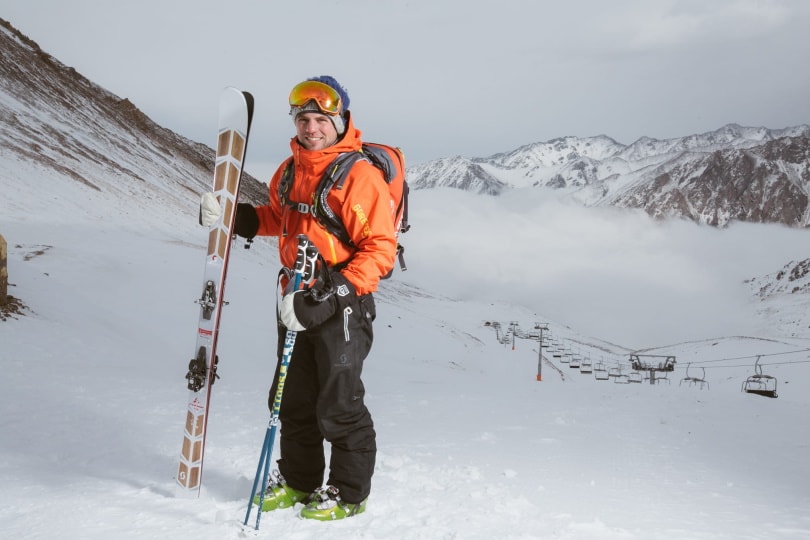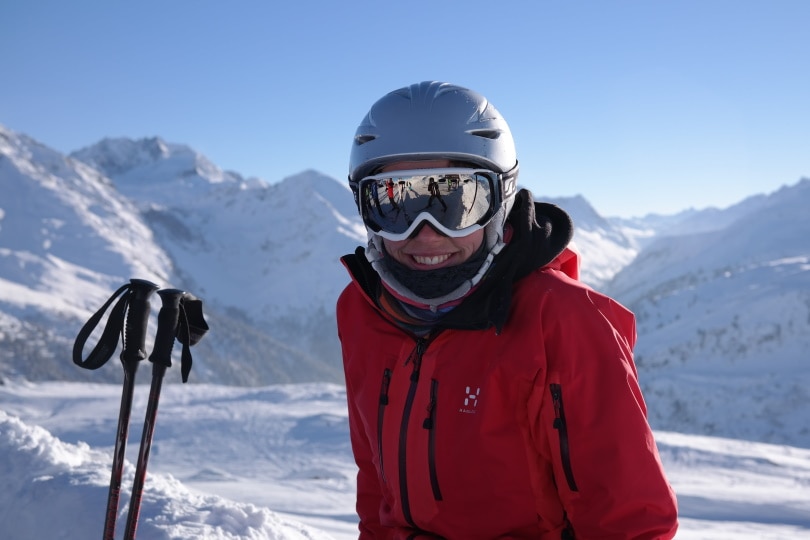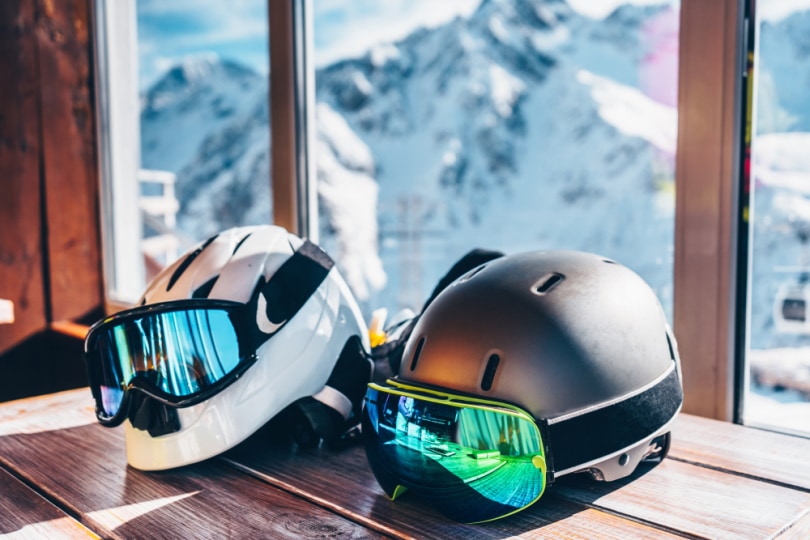Do You Need Goggles To Ski Or Snowboard? What You Need To Know
Last Updated on

Using goggles while snowboarding or skiing is not a requirement. However, if you want to protect yourself against UV rays, or reduce the risk of snow blindness, you should invest in a good pair. These goggles have been carefully designed to also make them effective at shielding skiers and snowboarders against cold winds that are strong enough to impair vision1 both in the short and long term.
Let’s look at why wearing goggles while skiing or snowboarding is probably a good idea.

Why Should You Use Goggles When Skiing or Snowboarding?
Cold, dry winds
The reasons are technical in nature, but it all boils down to the cold dry winds. Let’s assume you’re snowboarding or skiing down a slope at 15–25 miles per hour. It will only take you a couple of seconds to realize your eyes are watering up. The tears produced are not a sign of joy or sorrow, but a reminder that your eye is a sensitive organ that has to be protected—they were not designed to operate optimally in those conditions.
These cold and dry winds have the potential to significantly impair anyone’s vision—with or without a slope. They’ll freeze the eye’s cornea, or compel its blood vessels to constrict2. Consequently, leading to pain and/or loss of vision.

Snow blindness and the effects of ultraviolet rays
Medically, it’s a condition often referred to as photokeratitis. And even though it has “snow” as part of its name, it doesn’t always occur in its presence and is caused primarily by ultraviolet rays.
It’s no secret that UV rays have the ability to cause serious health conditions, and this is one of them. To make matters worse, they are usually stronger the higher you go above ground. So, when you’re skiing or snowboarding from the top of the hills and mountains you’ll be exposed to colossal amounts, thereby increasing your chances of developing the condition drastically.
Once your eyes are damaged, you won’t know right away. It can take up to 24 hours for the symptoms to start showing. Some of the documented symptoms include twitching of the eyelid, watering, swelling, mild headaches, redness in the eyeballs, and partial loss of vision.
The only good thing about this condition is the fact that it’s usually temporary. You’ll grapple with the symptoms for a couple of days, and then typically be fine. But if you wish to prevent permanent damage or speed up the healing process, these are some of the things that you could do:

- Use painkillers: They won’t cure anything but will reduce the discomfort.
- Apply eye drops: Your eyes’ surfaces will be susceptible to dryness and moisturization can help.
- Utilize a cold compress: This will be instrumental in reducing the swelling, and the pain to some degree.
- Stay indoors: The worst mistake that you could make is to expose yourself to more sunlight. Stay indoors, and if possible, in a dark room.
- Don’t wear your contacts: Contact lenses can impede the healing process of snow blindness. Take them off and don’t wear them until the symptoms subside.
What features make skiing/snowboarding goggles worth wearing?
Goggles rarely accumulate condensation courtesy of the following features: fans, vents, two-layered lenses, and anti-fogging coating.
The fans are mostly found on high-end goggles. In fact, they are part of the reason why this eyewear is so costly. They operate on batteries that are powerful enough to keep them running as they disperse the moisture that amasses over an extended duration.
Anti-fogging coatings are part of the goggles as well, but you’ll never miss them in mid-level eyewear. Needless to say, their primary function is to reduce or eliminate the effects of fogging. Their efficacy levels hinge on two factors: the amount of moisture present, and the goggle design. If the elements are too harsh, you’ll struggle to keep the moisture at bay. And the same applies if you went with a brand that doesn’t produce quality products.
Low-end goggles don’t have all these bells and whistles, but you could manually apply the coatings. If you’re working with a budget, look for goggles that have vents on the sides, at the bottom, and the top. They’ll help you deal with the moisture problem, and facilitate airflow without making your eyes dry. The only downside is that your face will feel colder than usual!
Speaking of cold—two-layered lenses are supposed to offer thermal protection in addition to preventing fogging. Goggles with multiple lens layers are designed to seal the skiers/snowboarders’ face, hence creating a barrier that is akin to a property’s storm windows.

Can sunglasses be used in place of ski/ snowboarding goggles?
Sunglasses cannot do the job that goggles do. They aren’t designed for that purpose, and even if you try to tweak them, you’ll still have to make compromises. Skiing goggles have a very wide field of view for a reason. Anything can happen out there, so you have to be able to see more of the observable world. You wouldn’t want to be caught off-guard while you’re at top speed in the middle of a slope.
There’s also the shattering-resistance ability of the goggle’s lenses. Upon impact, the lenses featured in sunglasses will most probably shatter and damage your eyes.
Assuming you’re riding in favorable conditions, you might be able to get away with it. “Favorable” in this context means there’s no wind, the temperatures are warm, no precipitation, and more importantly, the slope isn’t bumpy.
Are eyeglasses ideal for skiing/ snowboarding?
No, they aren’t either. No eyewear will provide the same level of protection that the goggles offer. They are all more susceptible to damage upon impact unless they are worn under the goggles.
Yes, several eyeglasses are compatible with goggles. And together, they’ll filter out all the unnecessary light being reflected off the snow and shield your eyes against debris or UV rays.

Who needs goggles more? Beginners or advanced skiers?
Goggles are important to every skier. It doesn’t really matter if they are just starting out or are at a more advanced level. We like to go easy on newbies because they seldom ski for extended durations, and even if they do, it’s rarely under extreme conditions.
That being said, if your eyes are sensitive, you have to wear them. If you need a snug fit that will provide a wider field of view, restrict airflow, stay in place anytime you hit a bump, and help you improve your balance—don’t go out there without them.
What’s the best lens color for a skiing goggle?
This will depend on the user’s taste or preference. You could go for gold, rose, green, greenish-blue, brown/amber, or yellow lenses. All you need to know is that lighter or darker lenses change the way you see things while snowboarding or skiing. The quantity of light that eventually enters our eyes through the lenses is known as the Visible Light Transmission(VLT).
Darker lenses permit less light to pass through and have a lower VLT. That’s what makes them ideal for day skiers. They shouldn’t be used on cloudy days, seeing as light reaching the earth’s surface is already minimal. Brands have different variations of darker lenses, but in general, they’ll either be gray, brown, or copper. They also like to add a reflective layer of coating on the outer surface.

Are goggles necessary at night?
Night skiing is becoming more popular these days. The sun is down so you don’t have to worry about snow blindness or any other effect caused by it. But the same can’t be said about the freezing temperatures, cold winds, snow, and several other debris.
If your major concern is visibility, you’ll be glad to learn that such areas normally have special lights installed to enhance your range of vision. On top of that, you have the option of wearing goggles made of clear or yellow lenses that are capable of accentuating details, thanks to their high VLT percentage.

Conclusion
Goggles have always been part and parcel of this sport. And they aren’t going anywhere, seeing as skiing and snowboarding are the types of activities that can render one blind without the right protection. Some people believe sunglasses are the perfect substitute, but this is not true for the most part. You’re far better off with purpose-made skiing goggles to protect your eyes and keep you safe.
- Related Read: Can You Wear Glasses Under Ski Goggles?
Featured Image Credit: Piqsels
Table of Contents
- Why Should You Use Goggles When Skiing or Snowboarding?
- What features make skiing/snowboarding goggles worth wearing?
- Can sunglasses be used in place of ski/ snowboarding goggles?
- Are eyeglasses ideal for skiing/ snowboarding?
- Who needs goggles more? Beginners or advanced skiers?
- What’s the best lens color for a skiing goggle?
- Are goggles necessary at night?
- Conclusion
About the Author Robert Sparks
Robert’s obsession with all things optical started early in life, when his optician father would bring home prototypes for Robert to play with. Nowadays, Robert is dedicated to helping others find the right optics for their needs. His hobbies include astronomy, astrophysics, and model building. Originally from Newark, NJ, he resides in Santa Fe, New Mexico, where the nighttime skies are filled with glittering stars.
Related Articles:
How to Collimate Binoculars: 9 Expert Tips
How to Clean a Refractor Telescope: Step-by-Step Guide
How to Clean a Telescope Eyepiece: Step-by-Step Guide
What Is the Best Binocular Magnification for Hunting? Optical Features Explained
How to Clean a Rifle Scope: 8 Expert Tips
When Were Binoculars Invented? History, Today & Future
Can You Use Binoculars to Look At Stars? How to Choose the Right Pair
How to Choose Binoculars for Bird Watching: 10 Expert Tips
